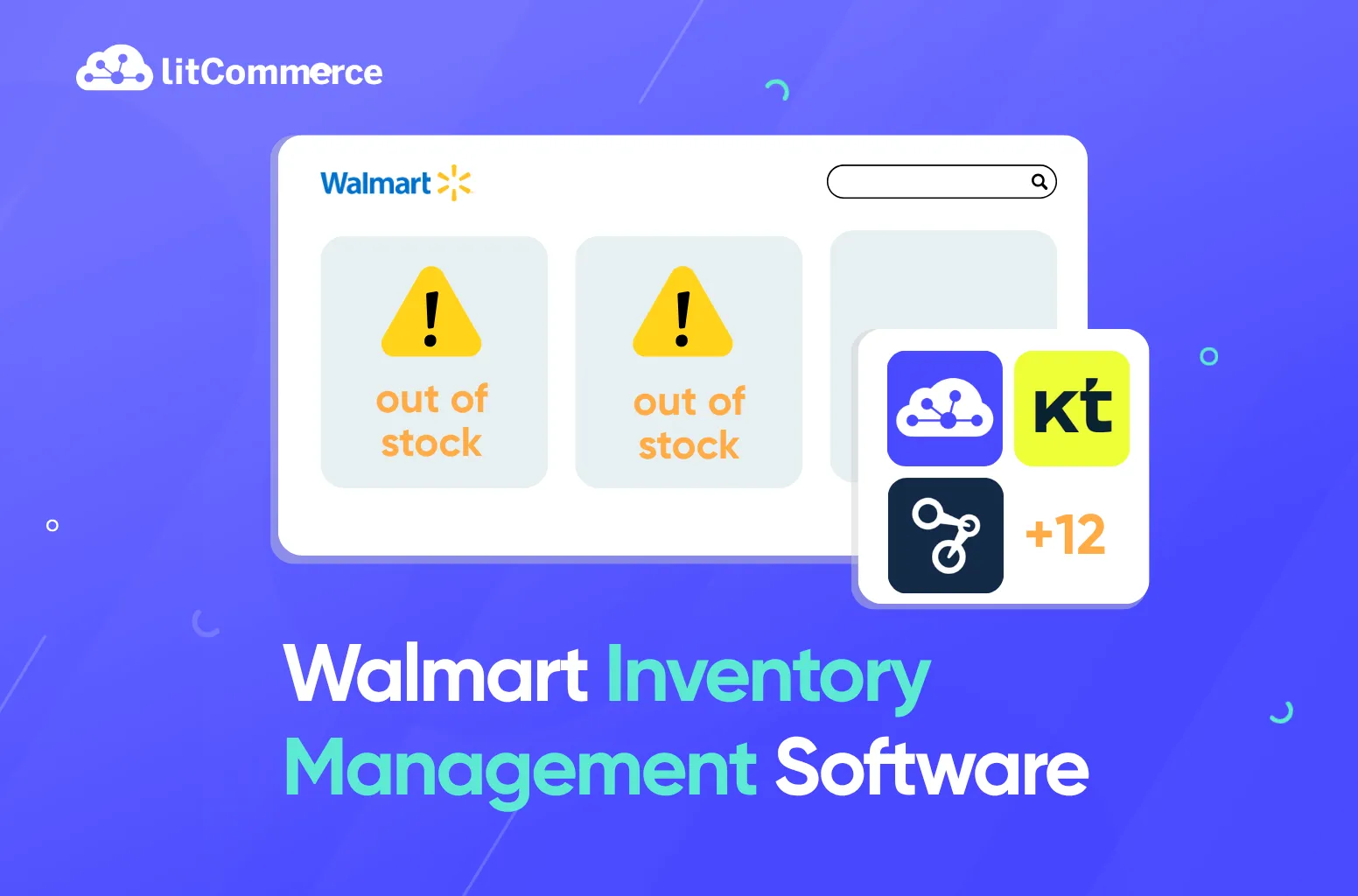Stockouts and overstocking, these two words that can keep any Walmart seller up at night. Both can hurt your profit margins, damage customer trust, and disrupt your store’s growth. While many factors can cause these issues, poor inventory management is often the biggest culprit.
That’s where Walmart inventory management software comes in. The right tool helps you stay on top of stock levels, automate updates, and avoid costly mistakes. But with so many options available, choosing the perfect one can feel overwhelming.
To make things easier, we’ve rounded up the 12 best Walmart inventory management software options that can help you save time, prevent errors, and scale your business with confidence.
Let’s dive right in!
Factors to Consider When Choosing Walmart Inventory Management Software
Since Walmart inventory management software can be a big investment, it’s super important to pick one that really pays off. Here’s what to look at when you’re choosing:
- Multichannel support: If you sell beyond Walmart (like on Amazon, eBay, or Shopify), pick a solution that supports multichannel inventory management. Hence, you can view and control all stock in one place, preventing overselling or discrepancies across platforms.
- Scalability and flexibility: Your inventory tool should grow with your business. Choose software that can handle increasing SKUs, multiple warehouses, and regional marketplaces as you expand.
- Ease of use and support: Even the most advanced system is useless if it’s hard to use. Go for software with an intuitive interface, simple setup, and responsive support, ideally offering live chat, tutorials, or easy-to-understand onboarding help.
- Pricing and ROI: Evaluate not only the subscription cost but also the value it brings; such as saved labor hours, fewer errors, and improved sell-through rates. Try to look for a Walmart inventory management app that offers free trials or flexible plans.

11 Walmart Inventory Management Software You Shouldn’t Miss
Below are top 11 Walmart inventory management software that will assist you to build a strong Walmart inventory system.
Software | Integration with Walmart | Key features |
LitCommerce | Direct Walmart integration | - List on 20+ channels - Free powerful listing editor - Customized sync options for each channel - Import all channels’ orders into one place - Real-time syncing for listings/orders/price/stock - Bulk import from marketplaces |
Katana Cloud Inventory | Via Extensiv (two-way sync) | - Real-time stock sync - Order import/export - Manufacturing planning - Open API |
M2E Cloud | Direct Walmart integration | - Automated inventory updates - Product & order syncing - Sales insights - Multichannel dashboard |
ShipBob | Direct Walmart integration | - Order import/export - Real-time tracking - Warehouse network |
SellerActive | Direct Walmart integration | - Inventory sync - Oversell protection - Repricing engine - Opportunity report |
Linnworks | Via SkuVault Core | - Centralized order management - Stock automation - Multichannel automation |
ShipStation | Direct Walmart integration | - Batch label printing - Order automation - Tracking sync - Carrier discounts |
Cin7 | One-way sync (two-way in development) | - ForesightAI demand planning - 700+ integrations - Walmart inventory management automation |
Ordoro | Walmart-compatible via integrations | - Label printing - Barcode scanning - PO management |
Veeqo | Direct Walmart integration | - Smart order routing, price & stock updates - Carrier connections - Warehouse workflows |
Agiliron | Direct Walmart integration | - POS & WMS sync - Unified dashboard - Automated fulfillment - Accounting integration |
1. LitCommerce
LitCommerce, an official Walmart’s full-service partner, is a multichannel selling tool that helps Walmart sellers easily list, sync, and manage inventory, products, prices, and orders across 20+ other marketplaces like Amazon, eBay, Etsy, TikTok Shop, etc. and eCommerce platform like Shopify, WooCommerce, Wix, etc.

Best features:
- Multichannel connect: Quickly integrate with multiple marketplaces and manage everything from one dashboard, no technical skills required.
- Real-time syncing: Customized sync of listings, inventory, prices, and orders to prevent overselling and out of stocks for each channel.
- Bulk product import to Walmart: Bring in products from your eCommerce platform and other marketplaces in a few clicks.
- Integrated order flow: Import all marketplace orders (including Walmart) into your eCommerce store orders page and process in one place.
- Free powerful listing editor: Edit, update listings quickly and consistently, either individually or in filtered groups.
- Insightful data analytics: Access real-time sales and inventory data across all channels to gain insights into order status and top-selling products, enabling informed decision-making.
Pricing:
Pricing Plans | |
7-day Free Trial | $0/ month - Full access to premium features. |
Pay as you go | Start from $29/month. Pricing varies based on the number of channels and listings – Ideal for growing businesses. |
Custom plan | Tailored pricing based on your specific business needs – Ideal for businesses with unique requirements. |
Best for: Walmart sellers managing numerous SKUs and selling across multiple marketplaces (Amazon, eBay, Etsy, etc.) or eCommerce sites (Shopify, Wix, WooCommerce, etc.) that need near-instant inventory synchronization and centralized order processing.
Start your 7-day trial with full premium features access
Explore every LitCommerce features, basic to advanced, to streamline and grow your Walmart store and across multichannel. No setup costs, no hidden fees, and you can cancel anytime.
2. Katana Cloud Inventory
Katana Cloud Inventory is a powerful inventory and manufacturing management platform designed for growing eCommerce and D2C brands. Through its connection with Extensiv, Katana seamlessly integrates with your Walmart Marketplace store, syncing sales data, inventory levels, and manufacturing workflows.
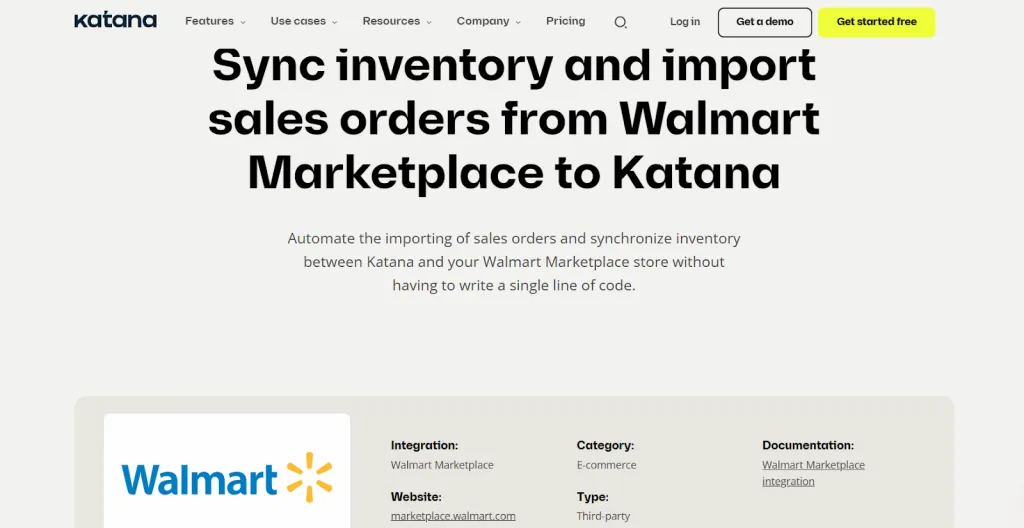
Best features:
- Seamless Walmart integration via Extensiv:: Connect your Walmart Marketplace store effortlessly without any coding or engineering setup.
- Automated order syncing: Import sales orders directly from Walmart to Katana for real-time production scheduling and inventory updates.
- Real-time inventory visibility: Instantly sync inventory levels back to your Walmart store to prevent overselling and stockouts.
- Smart manufacturing management: Align your manufacturing workflow with actual sales demand for better resource planning and efficiency.
- Multi-channel support: Integrate with top eCommerce, accounting, and reporting software like Shopify, QuickBooks, and Xero.
Pricing:
Pricing Plans | |
Free | $0/ month - 3 inventory locations |
Standard | $399/month - Advanced insights |
Professional | $899/ month - 10 inventory locations |
Professional Plus | Custom - Unlimited inventory locations |
Best for: Walmart Marketplace sellers who manufacture or assemble their own products and want a real-time, end-to-end inventory and production management solution.
3. M2E Cloud
M2E Cloud offers a seamless and effortless way to integrate your online store with Walmart Marketplace, helping you manage listings, inventory, and orders from one unified platform. Whether you’re a growing Walmart seller or managing multiple marketplaces, M2E helps you focus less on setup and more on scaling your revenue.
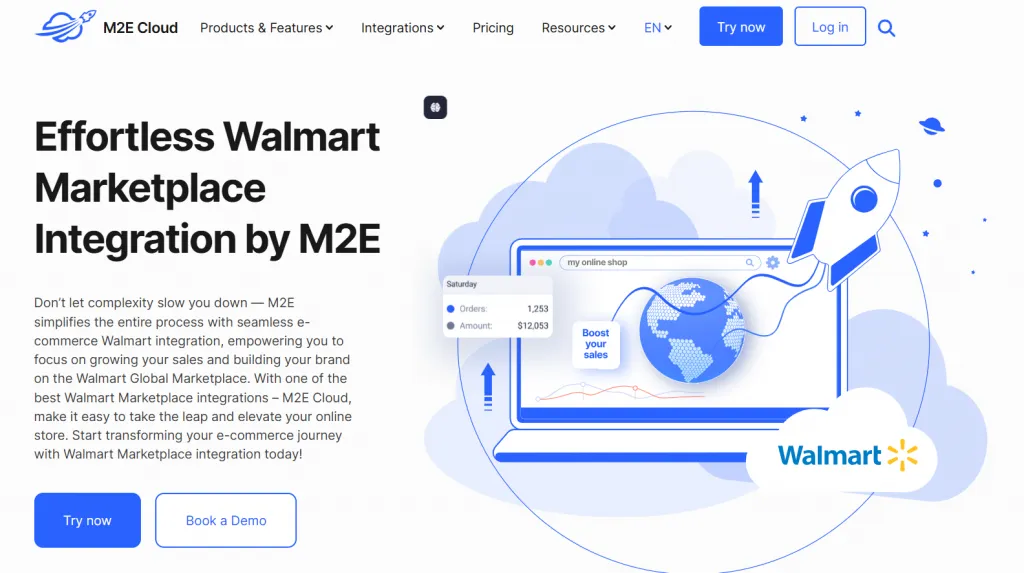
Best features:
- Effortless Walmart integration: Connect your store to Walmart Marketplace quickly without technical hassle and start selling faster.
- Centralized product management: Sync your product catalog with Walmart’s system for unified control over listings and pricing.
- Real-time inventory sync: Keep stock levels consistent across all channels to prevent overselling and stockouts.
- Sales tracking dashboard: Monitor order volume, cancellations, and weekly trends to optimize your sales performance.
- Multi-channel compatibility: Manage multiple sales platforms in one place, including Walmart US and other major marketplaces.
Pricing:
Pricing Plans | |
Starter | $0 - $79/month - Up to 20K active listings |
Business | $159 - $399/month - Up to 100K active listings |
Enterprise | From $799/ month - Unlimited seller accounts and integrations |
Best for: Walmart sellers looking for an automated multichannel integration tool to manage listings, inventory, and performance tracking in one streamlined platform.
4. ShipBob
ShipBob is a global fulfillment and logistics solution that integrates directly with Walmart marketplace to help sellers streamline their operations from inventory to delivery. Designed for scalability, ShipBob empowers Walmart sellers to expand faster with 2-day shipping, multiple US fulfillment centers, and international coverage to over 250 destinations.

Best features:
- Real-time inventory sync: ShipBob updates Walmart stock levels every 15 minutes to reduce overselling and keep listings accurate.
- Advanced fulfillment network: Access over 60+ fulfillment centers across the US, offering 2-day delivery options for faster customer satisfaction.
- Returns and tracking management – Generate and track returns directly within ShipBob, with tracking numbers automatically updated in Walmart.
- Inventory distribution tools: Place stock strategically across regions for faster replenishment and better shipping coverage.
- Custom packaging & branding: Elevate your brand with personalized unboxing experiences for Walmart customers.
- Open integrations: Connect to popular ecommerce platforms, ERPs, CRMs, and accounting tools to unify your entire workflow.
Pricing: Custom pricing based on your requirements
Best for: Walmart businesses seeking a scalable fulfillment and logistics partner to automate inventory syncing, and accelerate shipping times.
If you want to learn more about Walmart shipping cost to consider it as a factor for choosing a software that integrates with carriers, you can read it here.
5. SellerActive
SellerActive is feature-rich Walmart inventory management software and repricing solution designed to help sellers gain full control over their listings, pricing, and stock levels, all from a single, easy-to-use platform. With real-time syncing, automated updates, and powerful repricing tools, SellerActive ensures you stay competitive and efficient.
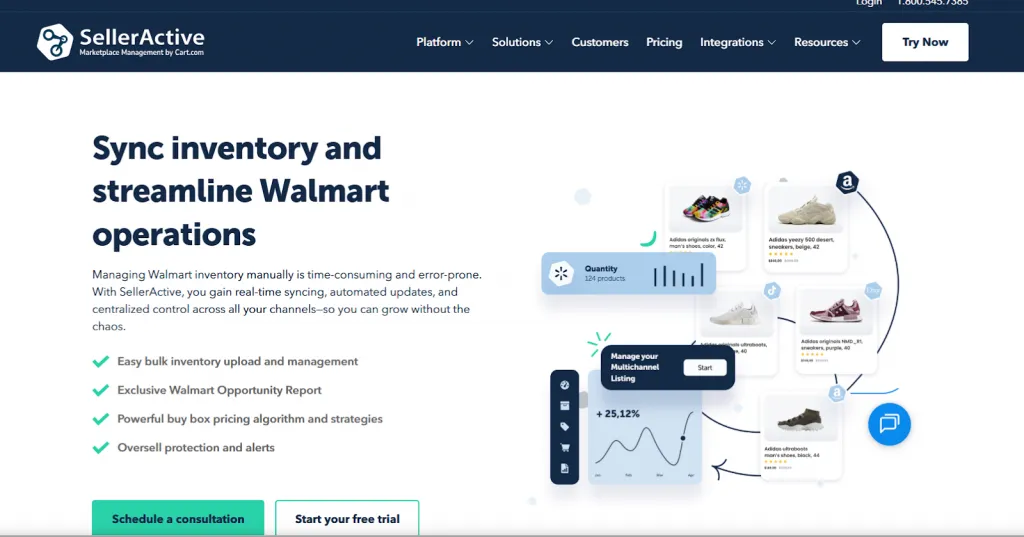
Best features:
- Real-time inventory sync: Automatically update stock levels across Walmart and other connected sales channels to prevent overselling.
- Bulk product uploads: Upload, edit, and organize multiple listings using intuitive templates that meet Walmart’s listing requirements.
- Price mirroring for compliance: Automatically adjust prices across platforms to stay Walmart-compliant while maintaining your profit margins.
- Exclusive Walmart opportunity report: Identify missed selling opportunities by scanning your catalog for high-demand or underpriced items.
- Oversell protection and alerts: Receive instant notifications and automatic adjustments to prevent overselling or listing errors.
Pricing:
Pricing Plans | |
Basic | $99/month - Monthly GMV limit $10k |
Premium | $209/month - Monthly GMV limit $25k |
Plus | $349/month - Monthly GMV limit $100k |
Custom | Varies - Monthly GMV limit >$250k |
Best for: Walmart sellers who want to automate inventory updates, and uncover new selling opportunities with smart pricing and real-time data insights.
6. Linnworks
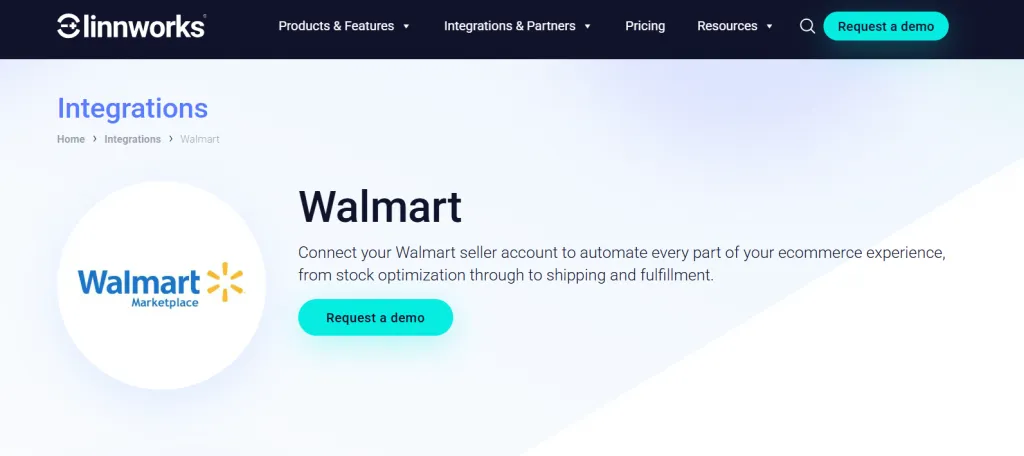
Linnworks, by integrating with SkuVault Core, pulls Walmart order information directly into your system and sends real-time updates back, giving you complete visibility and control over your stock at all times. With Walmart’s rapid eCommerce growth, Linnworks creates a Walmart smart inventory system, providing the automation and scalability you need to stay competitive and efficient.
Best features:
- Seamless Walmart integration: Connect your Walmart Marketplace account through SkuVault Core to automate order and inventory syncing.
- Real-time inventory updates: Automatically update stock levels across Walmart and other connected channels to eliminate overselling.
- Automated stock optimization: Balance inventory efficiently across warehouses to reduce carrying costs and improve product availability.
- Fulfillment streamlining: Simplify picking, packing, and shipping operations with built-in automation tools.
- Scalable multichannel control: Sync and manage listings across multiple marketplaces including Amazon, eBay, and Shopify.
Pricing: Custom pricing based on your specific needs
Best for: Walmart sellers looking to automate inventory, order, and fulfillment processes efficiently.
7. ShipStation
ShipStation is a trusted shipping and fulfillment platform that seamlessly integrates with Walmart Marketplace, empowering sellers to deliver fast, reliable, and cost-effective shipping experiences, whether you’re a small business or an established enterprise.

Best features:
- Seamless Walmart integration: Connect your Walmart Marketplace store in just a few clicks to automate order imports, shipping, and tracking.
- Centralized order & shipping management: Handle Walmart orders, shipping labels, and customer tracking updates from a single dashboard.
- Automated fulfillment workflows: Save time with batch printing, carrier rate comparisons, and automated shipping rules for every order.
- Real-time tracking updates: Automatically send tracking numbers to Walmart and customers for transparent, stress-free delivery.
- Multi-carrier support: Access discounted rates and ship with major carriers like USPS, UPS, FedEx, and DHL.
- Easy returns handling: Simplify returns by managing Walmart customer inquiries and return shipments directly within ShipStation.
Pricing:
Pricing Plans | |
Free | $0/month - Ideal for quick label printing and basic shipping. |
Starter | $14.99/month - Perfect for small businesses to set up and manage their shipping operation. |
Standard | $29.99/month - Designed for businesses needing more advanced capabilities that scale. |
Premium | $349.99/month - Built for larger businesses managing complex shipping and logistics. |
Best for: Walmart sellers who want to simplify fulfillment and provide fast, transparent deliveries from a single, easy-to-use platform.
8. Cin7
Cin7 is another Walmart inventory management software that connects suppliers, warehouses, and sales channels into one real-time system. Also, with over 700+ integrations, it helps connect every part of your business, from sales and accounting to fulfillment. While its Walmart integration currently supports one-way synchronization, ongoing developments promise even greater functionality in the near future.

Best features:
- Inventory forecasting with ForesightAI:Predict demand accurately to reduce overstocking and stockouts.
- Advanced demand planning: Identify top-performing SKUs, optimize reorder points, and fine-tune purchasing.
- Extensive integrations: Connect your tech stack effortlessly with 700+ integrations, including Shopify, Amazon, Xero, QuickBooks, and ShipStation.
- Industry-focused features: Designed for manufacturers, wholesalers, and retailers in categories like fashion, food, and health & beauty.
- Optimized order management: Automate purchasing, order routing, and fulfillment to improve accuracy and reduce manual work.
Pricing:
Pricing Plans | |
Standard | $349/month - Ideal for businesses starting their inventory management journey. |
Pro | $599/month - Ideal for growing businesses needing advanced tools. |
Advanced | $999/month - Ideal for high-volume businesses with complex operations. |
Omni | Custom - For enterprises needing fully customizable inventory solutions. |
Best for: Medium businesses and enterprises who need a comprehensive inventory system with deep integrations and forecasting tools.
9. Ordoro
Ordoro is a powerful multichannel inventory and shipping management platform designed to streamline fulfillment, reduce costs, and scale operations efficiently. With built-in automation, barcode scanning, and deep integrations across carriers and sales channels, Ordoro centralizes everything from inventory syncing to shipping label creation.
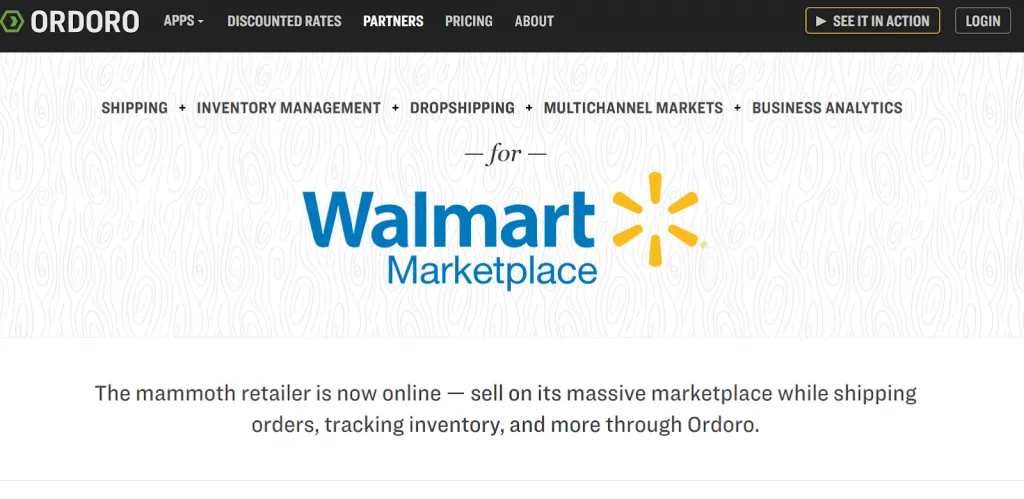
Best features:
- Centralized inventory management: Sync product quantities across all your connected sales channels, including Walmart Marketplace.
- Kit & bundle creation: Build and manage product bundles (multiple SKUs sold as one) to enhance your product offerings.
- Multi-warehouse connectivity: Connect multiple warehouses and choose how stock is updated across each location.
- Multi-carrier shipping support: Ship through USPS, FedEx, UPS, Canada Post, or DHL International.
- Barcode scanning: Minimize picking and packing errors while speeding up warehouse operations.
Pricing:
Pricing Plans | |
Advanced | $349/month - Track your inventory in all stores and warehouses. |
Premium | $499/month - Include purchase orders & custom forecasting report |
Best for: Walmart sellers, dropshippers seeking an automation-driven platform to unify shipping, inventory, and supplier management.
10. Veeqo
Veeqo is a Walmart inventory management software that helps sellers automate stock control, streamline fulfillment, and simplify multichannel operations. By bringing together your carriers, stores, and marketplace data in one centralized platform, Veeqo eliminates the need for manual spreadsheets and ensures accurate, up-to-date inventory across every sales channel.
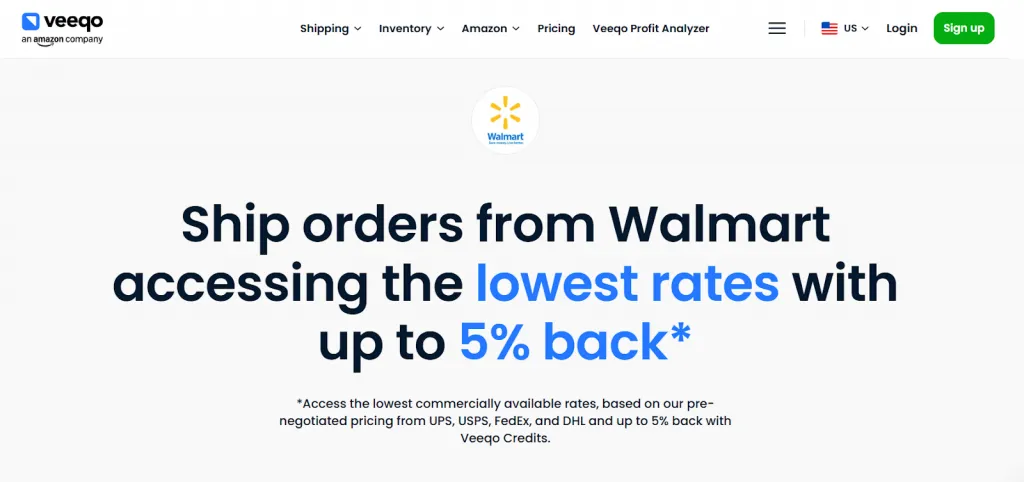
Best features:
- Smart order routing: Automatically fulfill orders from the warehouse or store location closest to the customer.
- Inventory sync: Manage inventory seamlessly across multiple channels, with automatic updates on stock levels and sales data.
- Automated price & stock updates: Adjust prices and stock quantities in one place and push updates to every connected marketplace instantly.
- Integrated shipping management: Connect major carriers and manage shipments, tracking, and warehouse workflows in one unified system.
- Warehouse optimization: Set custom fulfillment workflows and ensure inventory allocation only happens when stock is available at the chosen location.
Pricing:
Pricing Plans | |
Free | $0/month - Limited access to advanced features |
Priority | $250month - Offer a dedicated account manager |
Best for: Walmart sellers who want to automate multichannel inventory and shipping management and speeding up order fulfillment.
11. Agiliron
Agiliron is a comprehensive commerce ERP platform designed to unify your Walmart operations with your entire omnichannel business. It allows sellers to manage orders, inventory, POS, and warehouse data all in one place.

Best features:
- Omnichannel synchronization: Manage your Walmart Marketplace, online stores, and retail locations from a single unified platform.
- Centralized inventory control: Keep inventory levels synchronized across every sales channel.
- POS and warehouse integration: Connect your point-of-sale systems and warehouse management tools for real-time data visibility.
- Simplified order fulfillment: Automatically generate packing slips and shipping labels, ensuring smooth and fast delivery workflows.
- Scalable ERP foundation: Built to grow with your business, supporting both ecommerce and brick-and-mortar expansion.
Pricing:
Pricing Plans | |
Premier | $99/month - unlimited orders |
Enterprise | $199/month - Offer advanced inventory management |
Global Enterprise | $299/month - Support channels across multiple countries |
Best for: Walmart sellers and retailers seeking a unified ERP solution to integrate their online, in-store, and warehouse operations for true omnichannel efficiency.
Benefits of Walmart Inventory Management Software?
To boost efficiency and streamline operations, businesses often turn to external systems that complement the Walmart ecosystem. Walmart inventory management software is crafted to oversee every aspect of a business’s inventory, from handling suppliers to shipping products.
Here’s why a Walmart inventory management app can be considered as a game-changer for sellers:
- Improving inventory control and visibility: The Walmart store inventory system provides sellers with improved control and visibility. Precise tracking of stock levels, product availability, and optimized replenishment prevents both stockouts and overstocking, ensuring streamlined inventory management that meets customer demands.
- Streamlining order fulfillment: Sellers can experience streamlined order fulfillment with the Walmart inventory system. Efficient processing, automated routing, and real-time status updates not only enhance accuracy but also reduce processing time, elevating overall customer satisfaction.
- Managing listings efficiently and optimizing: Simplifying listing management for sellers, the Walmart inventory management software allows easy creation and optimization of product listings. With keywords, descriptions, and images, sellers can effortlessly maximize exposure, attracting more customers and boosting sales.
- Making data-driven decisions with analytics and reporting: Empowering sellers with data-driven decisions, the Walmart inventory management system provides robust reporting and analytics. Comprehensive data on sales, inventory turnover, and customer behavior allows sellers to identify trends and optimize strategies for better business outcomes.
- Collaborating and integrating with suppliers: The inventory management of Walmart encourages collaboration with suppliers. Sellers can seamlessly communicate, share data, and manage relationships, fostering efficient supply chains, minimizing delays, and ensuring a smooth flow of inventory to customers.
Walmart Inventory Management Software– FAQs
1. What is the best way to manage Walmart inventory?
The best way to manage your Walmart inventory is by using dedicated inventory management software that integrates directly with Walmart. These tools automate updates, sync stock across channels, and help prevent overselling.
2. Can I sync my Walmart inventory with other marketplaces?
Yes. Many Walmart inventory management apps like LitCommerce offer multichannel syncing, allowing you to connect Walmart with other sales channels such as Amazon, eBay, Shopify, and Etsy. This ensures that when an item sells on one platform, inventory is automatically updated everywhere.
Conclusion
Walmart inventory management is like a well-choreographed dance. It takes the right balance of smart software, data accuracy, and teamwork to keep everything in sync. The right inventory system doesn’t just prevent stockouts or overstocking; it helps you streamline operations, improve fulfillment speed, and make smarter business decisions.
Thus, choosing the best Walmart inventory management software ensures your business runs smoothly from order to delivery. Each of the tools we’ve covered offers unique strengths, so take time to find the one that fits your workflow, scale, and goals.If you’d like personalized guidance or have questions about the best solution for your store, feel free to contact us.

